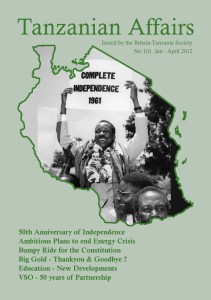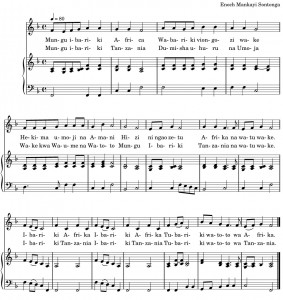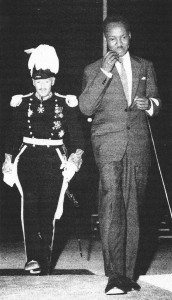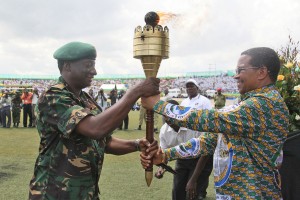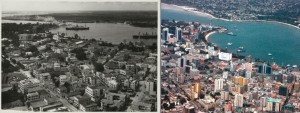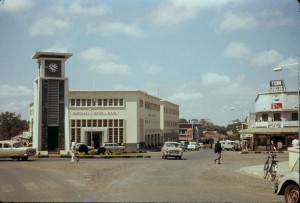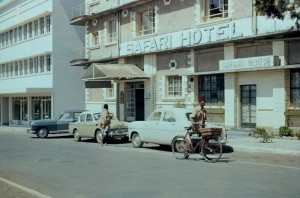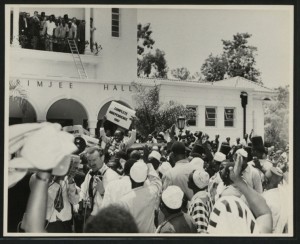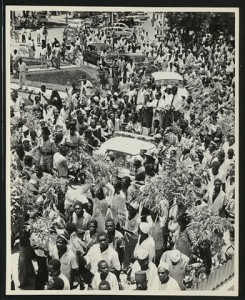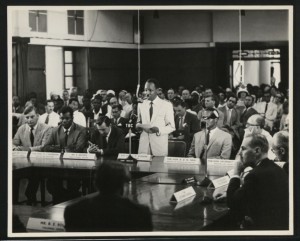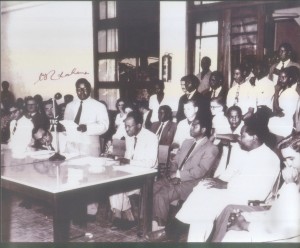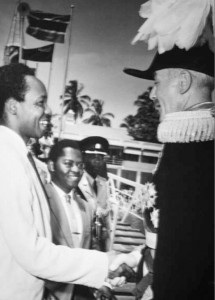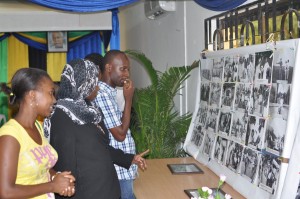Compiled by Donovan Mc Grath
To our readers: If you see an interesting mention of Tanzania in the newspapers and magazines you read, please let us know or send us a copy. Many thanks. Editor.
Best of ‘60s, ‘70s Tanzania music digitised – East African (December 12-18, 2011)
This article is based on a review of a recently released CD by Vijana Jazz Band, comprising influential music from Tanzania (1975-1980).
Extract: ‘The years after independence in [the] 1960s and 70s witnessed a boom in East African music driven by Tanzanian bands, which benefited from State patronage. Musicians of groups like Nuta Jazz, Vijana Jazz, Jamhuri Jazz Band and Cuban Marimba were paid official salaries and some were even employees of government departments… The only recording facilities available on Mainland Tanzania were to be found at the State-run Radio Tanzania Dar Es Salaam (RTD)… From the late 60s the radio station consistently sponsored and exclusively featured Tanzanian bands on its programmes, contributing to the development of a Tanzanian music style known as Mtindo. . . Vijana Jazz is considered among the most influential band of the “dansi” (dance music) era. Formed in 1971 the name Vijana (Swahili for youth) was a reference to the sponsorship by the youth wing of Tanzania’s ruling party… At the beginning of 1975 the members of the band entered the Hi-Fidelity Studios in Nairobi and recorded an album under the name Koka Koka Sex Battalion… In Tanzania, the bands created dance styles called mtindo … and Vijana Jazz became synonymous with “Kamata Sukuma” (grab and push) … In East Africa, Vijana Jazz became a household name with the song Niliruka ukuta (I jumped over the wall) a hilarious story of a man who has to flee when the husband of his lover returns home in the middle of the night… For the uninitiated, the vintage sounds here are a lesson in solid musicianship from an era gone by…’
Rock Paintings. South African Archaeological Bulletin (June, Dec 2011)
‘Emmanuel Bwasiri of the Antiquities Division, Dar es Salaam and the Rock Art Research Centre, Witwatersrand University, Johannesburg, has written in the South African Archaeological Bulletin about the challenge of managing intangible heritage resources in Tanzania. He refers in particular to the rock paintings at Kondoa Irangi, the Amboni Caves, and Kilwa Kisiwani, where local practices make use of these sites and artefacts in their belief systems. They are therefore sacred, but not always exclusively so. Bwasiri makes the point that current Tanzanian legislation follows the old colonial model of being concerned with the protection of physical artefacts and denying local people any part in their management, in spite of their importance to their traditional beliefs. This may be ascribed to proselytization by Christians and Muslims which has left traditional beliefs behind in the ‘respectability’ stakes, particularly in the eyes of westernised bureaucrats and politi¬cians. It contrasts strongly with attitudes elsewhere in post-colonial Africa – even post-apartheid South Africa – which encourage local people whose core beliefs tend to be traditional even if they have been Christianised or converted to Islam, to play an active part in the management of protected sites. This allows them exclusive rights for traditional ceremonies at particular times, and restricts the numbers of tourists who may view such sites; often stipulating that tourist guides must be locals who understand, and can explain to the tourists, those traditional beliefs.’ Nice to know we have readers in France. Thanks to Dick Cripps, Domaine du Poujol, 34570 Vailhauques, France, for this item – Editor.
Filbert Bayi, conqueror of Christchurch, hero of Tanzania’s 50 years of freedom – East African (January 30 – February 5, 2012)
‘This man was mad, said the experts, exposing himself as he did, setting himself as the man to catch’. Extract continues: ‘The starting gun went off and the beanpole sprang forward, took the lead position and kept it, staying there all the way to the wire… The distance between the beanpole and the pursuing enemy started narrowing, but not enough to dislodge the frightened escapee from his number one slot… A world record lay shattered in the dust … The date was the second of February, the Year of Our Lord Nineteen Hundred and Seventy-Four; the venue, Christchurch New Zealand; the event, the Commonwealth Games 1,500 metres final … Christchurch, thus, is a high mark in Tanzanian sporting history … the young man had done more to promote Tanzania in those three-minutes-plus in Christchurch than the combined efforts of all the country’s diplomats since independence… Athletes who came to take over from him have been formally recognised by their countries – Sebastian Coe is an English lord – but the erstwhile beanpole, today a balding and rather paunchy Dar es Salaam gentleman, failed to even catch the attention of those conferring medals to mark the 50th anniversary of Independence…’
Global drugs groups unite to destroy tropical diseases -Times (January 31, 2012)
Extract: ‘Deadly tropical diseases such as leprosy, sleeping sickness and guinea worm could be conquered by the end of the decade, under a pledge by a coalition of 13 global drugs companies brought together by Bill Gates … in an initiative dubbed the “London Declaration” … Britain’s biggest drugs groups GlaxoSmithKline and AstraZeneca are among the key players in the coalition, which will donate 1.4 billion treatments annually to impoverished countries and will spend $785 million (£500 million) making sure that medicines reach the right patients… The drugs industry has long been attacked by charities and developing countries for failing to invest in tropical diseases, as such medicines are rarely profitable. Investment has gone on “Western” ailments such as attention deficit disorder and irritable bowel syndrome. Health ministers from Tanzania, Brazil and Mozambique travelled to London to attend [the] launch …’
The true Tanzania: Discover balmy natural springs and booty-shaking African clubs away from the country’s uniform safari-and-khaki scene – TNT Magazine (March 12-18, 2012)
This amusing and witty piece by writer Adam Edwards foregrounds areas off the beaten track around Mount Kilimanjaro. Extract: ‘… My friends and I are cycling in Miwaleni Springs in the foothills of Mount Kilimanjaro – a meltwater aquifer about an hour’s ride from Tanzania’s main east-west motorway, along a sandy track that few outsiders have ventured down since the early Sixties, when the Union Jack was last lowered over this former British protectorate… “Let’s race!” cries Hereswida, one of our newfound Tanzanian friends … My friends and I have been in Tanzania for a couple of weeks, but until today we’d barely veered off the beaten track. We’re keen to discover more of this Tanzania … and beg our new local pals to show us more attractions the rest of the world has yet to discover. “Well, you’ve got to go to Pub Alberto,” says Jenifa … “They play the best bongo flava there.” … Pub Alberto’s raison d’être is its bongo flava, East Africa’s energetic, booty-shaking answer to hip-hop and R’n’B. The gyrating couples bump and grind to the sultry, intoxicating beat, making Rhianna look like a prude.’ Later on, Edwards humorously describes his experience riding in one of the local minibuses ‘towards a hand-hewn volcanic mine in Uchira … at the base of Kilimanjaro where Ernest, Jenifa and Hereswida live… Dala-dalas are designed to seat about 12 people, but anything up to 40 people, two goats and a dozen chickens can be crammed in these tiny vehicles… [I] manage to nab a seat opposite a couple of hefty nuns, chatting loudly to each other in Swahili. It’s not all plain sailing: the bus’s suspension seems to be on the blink and every jolt in the road has us bouncing like we’re on a fairground ride. One particularly nasty pothole sends me flying out of my seat towards the mother superior – I only narrowly avoid giving her a lap dance… Our next destination … [is a] huge caldera lake … the result of an enormous volcanic eruption some three-quarters-of-a-million years ago. It’s blissfully quiet; just us, a troupe of olive baboons … A peregrine falcon hunts stealthily overhead; tropical birds hum in the trees, a family of colobuses lounge by the lake’s lapping shore… My friends and I set up base in Marangu, former capital of Kilimanjaro’s Chagga [ethnic community], and explore the area. First on the list is a network of underground caves, hand-dug by the Chagga to protect against invasions by the Masai warriors, who used to regularly invade neighbouring [people’s] territory in pre-colonial times, plundering cattle and massacring entire communities in the process. A wizened old woman recounts in Swahili how [the Chagga] would lure marauding Masais into the network of tunnels before slipping out of specially designed escape routes and entombing the enemy inside… Intrigued, we decide to … [visit] the “Chagga Live Museum”, essen-tially a traditional hut built by local people to teach the now entirely Westernised [population] about their past. It’s a fascinating place – far superior to the tourist-trap Masai villages that line the motorway…’
Textbooks for Tanzania as BAE pays out over ‘bribery’ – Times (16 March 2012)
It began with a $40 million deal to supply an air traffic control system to an African country that could barely afford it. Thirteen years later, one of the most controversial episodes in recent British corporate history will end with BAE Systems buying new textbooks for eight million Tanzanian school children… After months of bureaucratic wrangling it had agreed the terms of a £29.5 million compensation payment to Tanzania… The Government of Tanzania and the Serious Fraud Office and Department for International Development, stipulates that the money will be used to fund education projects … Textbooks will be bought for each of the country’s 16,000 primary schools, and 175,000 teachers will receive upgraded equipment. Up to £5 million will be spent on buying new desks…’ Thanks to Betty Wells for this item – Editor.
Ex-Black Panther’s self-exile in Tanzania – East African (February 13-19, 2012)
‘In America, was an angry man, an ex-con who found a kind of religion in 1960s black nationalism. In a Tanzanian village, he’s been a champion of children.’ Extract continues: ‘… He rarely leaves home anymore. Crowds jangle his nerves; traffic makes his hands shake. Yet nothing feels more urgent than readying his bus [a 20-year-old, 29-seater Toyota Coaster under repair] for an improbable 300-mile trip to the edge of his adopted continent… A group of American high school students, mostly white, is gathering in the dining pavilion. They’ve been coming by the busload for years, many drawn by the intrigue of staying with a former Panther. They pay him $30 a night for a bunk. The money … with sporadic donations … pays the bills.’ Back in the USA, ‘… a federal judge [had] sentenced him to a four-year prison term on a conviction of transporting a shotgun across state lines. Out on bail, he decided to run. He and [his wife] Charlotte fled in 1970 to Sweden, then to Algeria, and finally, in late 1972, to Tanzania, whose socialist government welcomed left-wing militants. The O’Neals had $700. After a few years they bought a patch of inhospitable brush and volcanic rock in Imbaseni, a cobra-infested village of thatched-roof shacks in the country’s remote northern interior… Exile was supposed to be temporary… O’Neal’s exile became permanent. His fury abated. Some of it with age. Some of it was Tanzania, where strangers always materialized to push your Land Rover out of the mud, and where conflicts were resolved in community meetings in which everyone got to speak, interminably… A few years back, an ambition seized him. The village had scores of … orphans … He collected donations and built a concrete-block bunkhouse … He spread the word that he had room for a few kids. More than 100 appeared at his door … He had to send the majority away. The most desperate, a couple dozen, he informally adopted… They call him Babu. Grandfather… His orphans have never left this inland region of cornfields and malarial swamps. They’ve never tasted salt water, or felt hot beach sand between their toes… The 29-seater is ready by late summer… One day soon, he hopes to take the children southeast across the country to the Swahili Coast, with its coral reefs and pale sand, and bright-painted old dhows…’Look how Tanzania played catch-up after Mwalimu – East African (December 12-18, 2011)
The 50th anniversary of Independence is both a cause for celebration as well as a time for reflection on the reversals of so many of Mwalimu’s achievements that set Tanzania apart from so many of the post-Independent countries of Africa. Mwalimu’s influence went well beyond the territory that he led to Independence… As Tanzanian people today reel under the impact of the concessions subsequent governments have made to the international finance institutions, as they suffer assault of neo-liberal policies, as the commons that Nyerere fought so hard to retain as a public right is privatised, it is really only now that many have begun to realise the extraordinary achievements of the Nyerere years. Whatever criticism many of us may have had – and continue to have – about some of his policies during his lifetime, there is no getting away from the transformations that he brought about. One only has to look at the scale of theft and pillaging, the failure of the national project, the politicisation of ethnic identity, the open collusion with transnational corporations in the plunder of resources, that characterise neighbouring countries to understand what efforts Mwalimu had made to prevent the same happening in Tanzania… It is time both to celebrate Tanzania but also to reflect on the tragedy of the reversal of so many gains in the early years of Independence…’
Where a toothache can kill – Geographical Magazine (Royal Geographical Society, December 2011)
‘Dentists are thin on the ground in rural Tanzania and too expensive for most people… [Sutherland-born dentist Ian Wilson] has made it his mission to improve the state of the country’s dental care.’ Extract continues: ‘It was one of the worst cases Ian Wilson had ever seen. The man’s jaw had been broken in two places. And not by a wild punch, or an unlucky accident – but by a traditional healer. Pulling teeth… “They left him with a broken jaw for two-and-a-half years,” he says… in his role as founder and clinical director of the dental charity Bridge2Aid (B2A [founded in 2002]) based in Mwanza … All too often, it’s still to the traditional healers that locals turn… “Rural Tanzanians suffer, on average, for two years with often severe dental pain before they see someone. So they either pull out teeth themselves – or they pay one of these guys to do it.” … “It’s no joke,” he says, “In some parts of the world, it’s still possible to die of a toothache.” … When not treating his patients, Wilson is often out with his teams helping to train local clinical officers in the basic dental skills … Once B2A finishes training a clinical officer, it equips them with a basic dental toolkit, which they use to safely extract teeth and apply fillings without the need for electricity or water (or even chairs).’ Thank you David Kelly for informing us of this article. And thanks to the Geographical for sending in the relevant part of this issue – Editor.
So homosexuality is unAfrican? What about living on handouts? – East African (November 7-13, 2011)
“No self-respecting African man would let another man pay for his wife’s and his children’s upkeep,” says columnist Jenerali Ulimwengu. Extract continues: ‘For a country that once had ambitions of becoming a self-reliant nation, Tanzania is a surprisingly donor-dependent place… Whereas loans and credit lines impose the responsibility of repayment, free money makes the recipient a virtual beggar and keeps him beholden to the donor. And yet Tanzania, even under the old man [Julius Nyerere] himself, went ahead and accepted foreign money, loans and grants in huge sums, especially in sectors such as education, health and water sanitation. The dependency grew so great that when Olof Palme, the Swedish social democrat who had underwritten Nyerere’s education programme, lost power, Tanzanians felt the impact probably more acutely than the Swedes… [A] few years ago we reached some benchmark that convinced our donor countries that we had become a highly indebted poor country (HIPC). And we celebrated with a beggar’s dance, bowl in hand… In the past, our beggar practices were streamlined in such a way that we could borrow or beg to meet capital or development programmes. Now we can borrow to pay government employees and other charges (OT), which gives dependency a new and menacing dynamic…’
The Malawi connection with Zanzibar – Habari (Sweden-Tanzania Society, August 2011)
This article was created from a web discussion about the connections between Malawi and Zanzibar. The distinguished Swahili professor, Maalim Abdulaziz Lodhi, gives background to the Zanzibar Revolution and to several politicians in Zanzibar. Extract: ‘I think the Malawi connection in Zanzibar is the disputed “zanzibariness” of Sheikh Abeid Aman Karume, the first President of Zanzibar (1964-1972) and father of Dr. Aman Abeid Aman Karume (6th President of Zanzibar 2000-2010). The Sheikh (also known as “Fadha Karume” by some) is believed to have been born in Malawi of Malawian Muslim parents who immigrated to Zanzibar. . . The Karume family also had close ties with Dr. Kamuzu Banda’s family and the Sepetu family. The family name Karume is from the old Nyasaland among the speakers of Chichewa … In Swahili, this language Chichewa/Chinyanja was called “Kinyasa” and its speakers were referred to as “Wanyasa”. Sheikh Karume was also referred to as “Mnyasa” by some people in Zanzibar before the Revolution… I’m told Issak Sepetu, who was born in Malawi and came to Zanzibar as a Malawi citizen, was never naturalized as a Zanzibar citizen, and therefore cannot be a Tanzanian citizen, but he was a Tanzanian Ambassador anyway! Several others like him, “Field Marshal” John Okello being the best example of those “revolutionaries” and other leaders or politicians in Zanzibar who were not Zanzibaris, rose to high ruling positions in Zanzibar after the Revolution. Okello did not even speak proper Swahili! … Issak Sepetu tried also to be nominated for the presidential election in Zanzibar, but the Zanzibar leadership opposed him on the grounds of not being a “Mzanzibari halisi” (genuine Zanzibari). To date, little is known or written [and] published about this Zanzibar-Malawi connection…’
Now late blooming Dar goes online, media grasps power of social sites – East African (February 20-26, 2012)
‘As Facebook and Twitter gain popularity, newsrooms are starting to appreciate their significance in media operations but a generational divide persists.’ Extract continues: ‘In Tanzania … media houses are starting to notice the potential of the web. The three most prominent print media organisations [Tanzanian Standard Newspapers, IPP Media, Mwananchi Communications]… all have a presence online… But when it comes to incorporating social media platforms such a Facebook and Twitter into their work patterns, the picture gets complicated… However, as Facebook and Twitter gain popularity in the country… newsrooms are starting to recognise the significance of utilising these tools in their news operations… Last month, the Daily News revealed its newly revamped website, http://dailynews.co.tz, specifically designed to integrate social media…’
A land of many wonders – New African (December 2011)
‘Tanzania is famous for its tourism sites. Mount Kilimanjaro, the Ngorongoro Crater, the Olduvai Gorge, Lake Victoria, Zanzibar Oldoinyo Lengai – and there are 44 more such wonders! And Tanzania wants to be even more famous as a tourism destination by diversifying its tourism products. The next five years will be an exciting time in the land of Kilimanjaro!’ Extract continues: ‘… In 1959, a time when most of Africa was under the colonial yoke (with the exception of 8 countries – Liberia, Ethiopia, Egypt, Sudan, Ghana, Libya, Morocco and Tunisia), a fresh-faced young man of Tanganyikan origin addressed the Tanganyikan Legislative Assembly and promised the following: “We the people of Tanganyika would like to light a candle and put it on top of Mount Kilimanjaro which would shine beyond our borders, giving hope where there was despair, love where there was hate, and dignity where there was before only humiliation.” That young man was called Julius Kambarage Nyerere. On 9 December 1961, his wishes came true. On that day – Tanganyika’s Independence Day – Lt Alex Nyirenda, with a commission from Nyerere’s newly-installed government, went up to the top of Mount Kilimanjaro, and with the new flag of the new nation fluttering proudly in his left hand, attached the Uhuru Torch to the flagpole to symbolically shine over the country and across its borders. The black and white photo of this historic event evokes memories of the American landing on the moon eight years later (in 1969). Perhaps the Americans stole the shot from the Tanzanians, and maybe Mrs Thatcher, Britain’s Iron Lady, was inspired even much later in 1979 when she became the UK’s first female prime minister, as she appeared to follow Nyerere’s lines on her arrival at No 10 Downing Street: “Where there is discord, may we bring harmony. Where there is error, may we bring truth. Where there is doubt, may we bring faith. And where there is despair, may we bring hope,” Mrs Thatcher said, paraphrasing the “Prayer of Saint Francis” as Nyerere had done 20 years before her… As part of the celebrations, the [Tanzanian Tourist Board] is organising to prime events to remind the country and the outside world of Nyerere’s and Tanzania’s commitment to peace and freedom through tourism. In the main event, Dr Nzuki [managing director of TTB] will lead the TTB in a recreation that will see 200 climbers from across the world attempt to scale Africa’s highest mountain to the peak where Lt Nyirenda stood 50 years ago and planted the Uhuru Torch… The second event is a Special Walk from Mwanza on Lake Victoria to Butiama in Mara Region, where Nyerere was born and buried… Dr Nzuki proudly tells how Tanzanian tourism has grown from a small, government-run industry in the 1960s, to one where it now contributes 17% of the nation’s GDP…’
World’s highest lava tunnels found on Mt Kilimanjaro – East African (October 31 – November 6, 2011)
Extract: ‘A team of three Dutch cavers [Sjoerd Vander Schuit, Arjan Van Waardenburg and Bert Tindemans] have discovered the world’s highest lava tubes on Mt Kilimanjaro, giving the mountain an additional tourist attraction… The largest of the tubes is 150 metres long and between eight and 10 metres wide … The Dutch team found the tubes on the slopes of Kibo and Mawenzi peaks of the mountain… Lava tubes or lava tunnels are … natural conduits through which lava travels beneath the surface of a lava flow. When the lava flow ceases, the rock also cools, leaving a long, cave-like channel… The discovery will be circulated widely across the globe through magazines and websites… A tour guide, Gadiel Majefu, urged the Kilimanjaro National Park Authority to preserve the new tourist attractions… “Mt Kilimanjaro is among the 28 finalists for the New Seven Wonders of Nature,” [Rashid] Mtungi [managing director of Tanzania Rift Valley Tours], said, adding that the breakthrough would encourage more people to vote for Mt Kilimanjaro…’
Mafia Money allegedly sent to Tanzania. Il Messagero, Italy
The Italian newspaper Il Messagero was one of many which, over Easter, were full of allegations about money for election expenses being illegally sent to Tanzania for private investments.
The Northern League party, campaigning for independence for the Northern regions of Italy, has received legitimate funds from the outgoing Italian Government for electoral expenses. However the party treasurer, who enjoys a lot of freedom of action, has allegedly sent 6 million Euros (£5.4m) of these funds to Tanzania for investment in the diamond industry. The allegation, made by the Italian Government’s Anti Mafia Commission, came from evidence obtained by wire taps and links this money with money laundering by the Calabrian Mafia, the N’drangheta.
No details for the actual investments in Tanzania were revealed by the Italian newspapers but it begs the question of how much other “mafia” money has found its way to Tanzania. Thank you Tony Janes for sending this from Italy – Editor.



